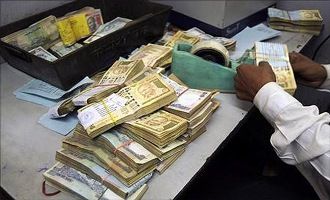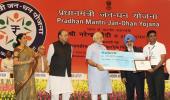A lot of initiatives were thought out, and many of them were implemented; but a major lacuna in the drive towards financial inclusion earlier was the fact that very few of the poor had bank accounts, notes Shubhashis Gangopadhyay.
 In his Independence Day speech, the new prime minister talked about financial inclusion.
In his Independence Day speech, the new prime minister talked about financial inclusion.
This was not new.
We have been hearing about financial inclusion (or corresponding phrases) ever since bank nationalisation was undertaken in 1969.
Since then, reams of papers and scores of speeches have eulogised this great ideal and, hence, the need to do something about it.
However, there never was, at least in action, a strong commitment by the leadership to achieve this goal.
A lot of initiatives were thought out, and many of them were implemented; but a major lacuna in the drive towards financial inclusion was the fact that very few of the poor had bank accounts.
Even this was repeatedly talked about -- and indeed one of the major stated positives of the Aadhaar initiative was that people with Aadhaar cards could seamlessly open bank accounts without any other documentation.
However, what is new about the prime minister’s speech was actually what followed it.
Within two weeks of the speech, the prime minister flagged off the Pradhan Mantri Jan Dhan Yojana, and the day was marked by announcing its outcome on the very first day of its implementation.
The prime minister himself was present at the launch and announced that as many as 15 million new accounts were opened by the end of the working day.
In other words, not only were things not forgotten for many, many months till after the speech, but the next announcement was a report on the implementation plan and its current “outcome”.
And the most important thing about the implementation was that it used government institutions and the government banks to implement it.
This latter method of implementing governance initiatives should not be missed.
For too long, the same people who have opposed cash transfers as a symbol of the government’s throwing money at problems and moving away from its commitment to implement affordable access have been perfectly happy with government schemes being implemented by non-governmental agencies.
While our public-private partnership with businesses have been faltering at all levels, the PPP initiatives with non-profit non-governmental organisations have been going from strength to strength in the last decade or so.
Unfortunately, governance is best implemented by the government.
Why? Simply because people can hold the government accountable (however imperfectly it might be) in a democracy; it is impossible for people to hold other agencies similarly accountable.
Non-governmental agencies are not open to public scrutiny; they have no public disclosure systems in place and, therefore, it is a bit unfair to allow them access to public money being used for governance measures.
Relying on non-governmental agencies for the last-mile delivery of government services has allowed governmental agencies to get away by disbursing the money without any follow-up of the outcomes of the various well-intentioned schemes.
The argument for using non-governmental agencies for standard governance activities is that India is a diverse country and ground-level implementation requires a certain degree of flexibility unavailable to government officials.
Once government decides to focus away from processes to outcomes and particular means of attaining those outcomes are banned, rather than procedures prescribed by some detached central-level official, ground-level government officials will have enough flexibility to fine-tune methods of attaining the outcomes specified in any governmental scheme.
After all, that is what one is doing by leaving the last mile in the hands of non-governmental agencies.
In doing so, however, one is removing the last-mile activities from public scrutiny and allowing government officials to show that they have followed all prescribed procedures.
Initiatives, like financial inclusion for all, have to be institutionalised and cannot be left to private initiatives of good people.
Society has elected a government to do this, and they want to be able to scrutinise what the government is doing with the money that belongs to the people.
The other encouraging part of this initiative is the fact that this account allows an overdraft facility of Rs 5,000 to each accountholder.
A poor person who does not have access to institutional sources of credit was being forced to go to moneylenders who charged what were called usurious interest rates.
To address this, we created a national policy to support microfinance institutions through various subsidies and interest rate subventions.
All calculations kept showing, however, that these rates were also many times higher than bank rates when one considered the effective cost of borrowing from these institutions.
Indeed some calculations even argued that they were as high as that of moneylenders in spite of the subsidies that the money lender never got!
The overdraft facility squarely addresses this problem and does so at interest rates that are effectively lower than what the moneylender will charge.
And it has the right incentive -- the first overdraft is automatic and after that, you can use this facility as many times as you want as long as you pay back the earlier amount -- for the outstanding amount at any time is capped at Rs 5,000.
After all, most of the loans given by most of the good microfinance institutions are of similar amounts.
Such a method of institutionally driven financial inclusion will also make financial policy more effective for it reduces the informal sector in financial markets that the poor currently depend on.
The banks will now have the data on loans to the poor; and the Reserve Bank of India, which implements monetary policy, will have access to this data.
So their policymaking will be more data-driven and, hence, better informed.
Too much of policymaking is made with data on formal markets, while a large part of the economy stays informal.
This not only reduces the effectiveness of policies, it could also result in the wrong ones.
Shubhashis Gangopadhyay is research director, India Development Foundation, and director, School of Humanities and Social Sciences, Shiv Nadar University











